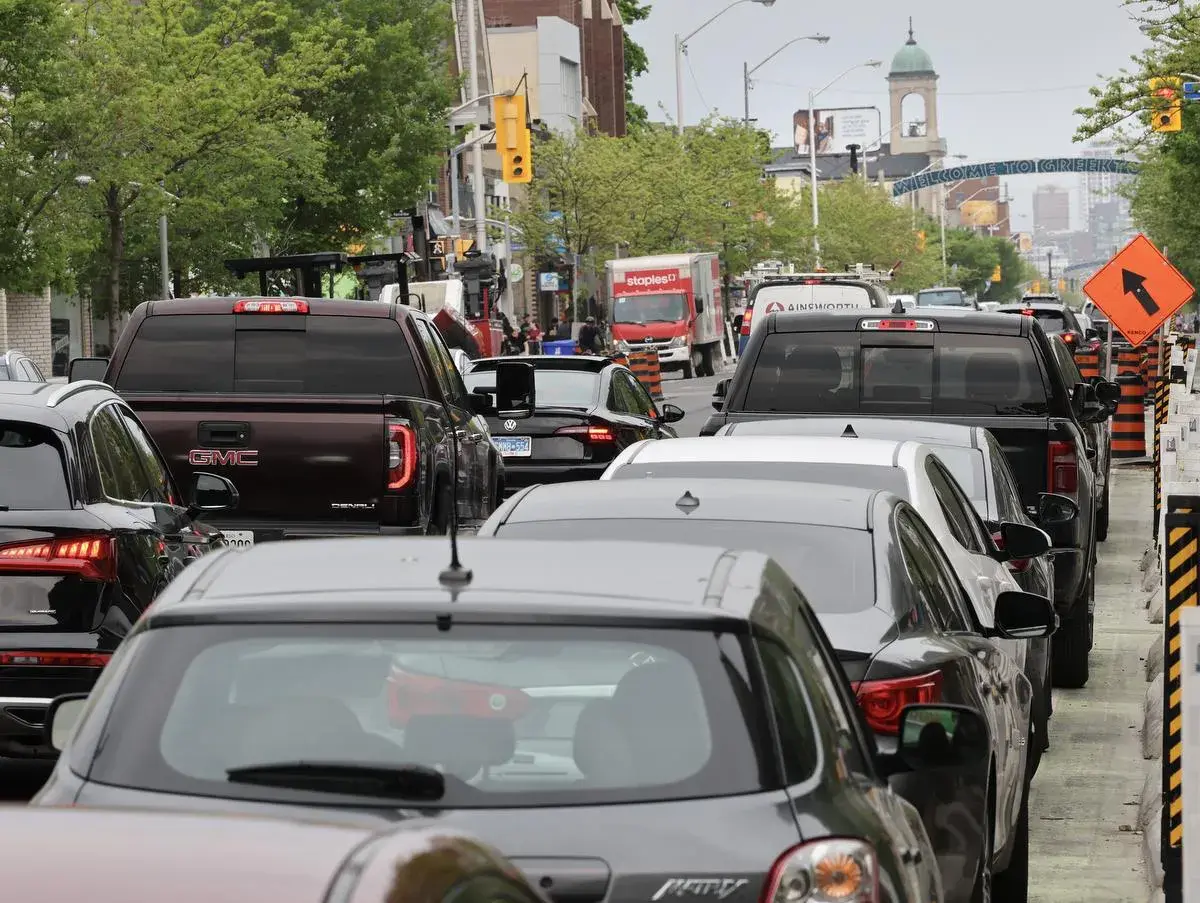You can move more people by getting some of them to take transit or ride bikes or walk to work, though they are quickly replaced on the road by enough cars to keep the speeds more or less the same (induced demand again).
Did this guy just make the argument that shifting people to cycling and public transit just induces more demand for driving? What a profoundly stupid idea.
Shifting people to active and mass transit options requires making those options more efficient than driving. It means fighting and winning a god damn war on the car; taking away space from cars and giving it to active and mass transit options. At a certain level it is a zero sum game. So no, after the shift to bikes and not just bikes, cars are not coming back.
I think maybe he meant it was a critical mass thing. If you half-ass your cycling and pedestrian infrastructure (ie.: basically all of North America), you remove or narrow motor vehicle lanes. Few people ditch their cars for cycling or walking because the infrastructure still sucks, so all you end up doing is having a bit less space for practically the same number of cars.
Either you make the cycling infrastructure usable and comprehensive or it doesn’t work at all.
The whole argument around induced demand is that people have a certain ‘tolerance’ when choosing a mode of transportation, and if an option becomes intolerable then they’ll switch modes to a more tolerable option or forego trips entirely. If enough people mode shift to public transit and cycling then driving becomes faster and some people will switch back to driving or drive for more trips they otherwise wouldn’t take until an equilibrium is once again reached between speed and tolerance, so the author’s argument is the only way to ensure this equilibrium is reached at speeds that drivers desire is to reduce the number of people in the city overall.
Since this isn’t a realistic option, the author argues that ‘fixing traffic’ needs to be re-framed as ‘improving the quality of life for people.’ As long as politicians are obsessed with ‘fixing traffic’ via increasing car speeds and reducing delays for drivers things like cycle tracks and transit lanes are a political albatross around their neck, but if politicians instead frame the objective as improving the quality of life for people moving around the city then things like building more transit lanes, cycle tracks, pedestrianized streets, etc. become more reasonable and justifiable.
For sure I agree that “reduce traffic” is the wrong metric and “improve quality of life” is the right one.
Did this guy just make the argument that shifting people to cycling and public transit just induces more demand for driving? What a profoundly stupid idea.
If we agree the idea (or the fact) of induced demand, then it logically follows that taking people out of cars and into the TTC or onto bikes frees up space on the street which produces induced demand. Nothing stupid about it - straight up logical deduction. :D Unless you take so many people out of the street that the induced demand fails to saturate the streets. Which as the author says doesn’t seem to happen in cities where people want to live in. It’s not a politically useful argument, but it’s valid. 😄
To take people out of cars and onto transit, you must make those options more attractive, efficient, safe, fast than cars. That means taking space from cars to give to protected bike lanes, to separated bus lanes, to pedestrian traffic etc. When you have done that, you remove the thing that induces car demand in the first place.
Yes but the next step is for people formerly in cars to move to these alternate modes of transportation which have higher density, thus if you’re really successful at it, at least initially, freeing up more space than you took. Under that possibility, we end up with more empty space on the now narrower street. Which induces demand.
Again, I’m saying that under these assumptions, the author’s argument is valid. I’m not saying it’s valid in all circumstances or that’s it’s actually useful, outside of what he used it for. He made it to show that even if we’re very good at improving the quality of life of commuters we shouldn’t expect to have F150s driving at 50kph through downtown. It’s not an argument I’d use in any other setting as it can be misused very easily by people that don’t want improved transit or bike infra.
Maybe I’m misunderstanding. Is the argument that “if you don’t take space from cars then they will just come back”? If that’s the point, sure.
However, it is true that in a city that is no longer car centric, the people who actually need to drive (emergency vehicles, some categories of disabled people, etc) do have an easier time driving.
Alot of people here in suburbia Scarborough hate bikes, and they regularly break the rules by riding on the sidewalk due to it being unsafe to ride on main east-west/north-south roads. Even the bike lane on hunting wood is a joke as cars are always parked in the biking lane, and there is zero traffic enforcement here.
What a hot take. I was really expecting them to speak about increasing bike lanes and making more transit lines, not tanking the economy lol
It does highlight how the entire argument around ‘fixing congestion’ needs to be re-framed. If the goal is just to ensure that cars can drive quickly through the city then the only way to guarantee that is to reduce the number of people who want to move around the city by tanking the economy and ensuring nobody wants to live or work here anymore.
If the argument is re-framed to ‘improve the quality of life for people moving around the city’ then suddenly options that move more people in a more pleasant manner become more palatable, even if that improvement comes at the expense of personal vehicles moving slowly. IMO nearly every lane with a streetcar track should forbid personal vehicles, and more of our overly wide roads in the outer suburbs should convert a lane in each direction to a dedicated transit lane, but as long as the focus is on improving car speeds and reducing car trip times these options are dead in the water because they’ll make ‘congestion’ worse.
I wonder if it’s some anchoring effect technique. Suggest taking a hot dump on the economy and suddenly bike lanes don’t sound so bad to a lot of people by comparison.
The other thing that can work is the thing no candidate will ever suggest: if you completely and permanently crash the economy to such an extent that the population dramatically shrinks, then traffic problems go away.
For once, the clickbait paid off. That’s one spicy take I did not see coming.
cities reporting no traffic congestion at all and downtown speeds of 40 km/h or more are generally places like Scranton, Pa.
Dunder Mifflin in shambles right now
Why not till the highways into the city? They are used by our of towners.
Then you would be charged a fee anytime coming in or out of the city, I already do not agree with the 407 and hate that it is a privatized entity that owns it. IMHO, making improvements in transit infrastructure would personally make me less likely to drive, and making improved bike lanes so it is less dangerous to drive in the city.
For most out of towners even with improved transit they will still use their cars.
Now taking even more space, arriving in F150s and RAMs. Gotta have that elevated driving position! 🥲
I find this all really funny because we actually have some great infrastructure success examples here in Toronto. The UP train and the 509 / 511 are just fantastic for getting into the city, and or getting to Pearson. My wife and I never drive downtown, why bother when the transit options are faster and more convenient?
Hahahahahaha. In a similar vein, as mayoral candidate Doug “Dimsdale Dimmadome” Dimmadome here’s my “20km/h Plan”. All traffic is going to go at least 20km/h no matter what.
How, you ask? Well we’re not using these snowplows for half the year, and just budget in a few supercharged CAT D11s to go 20km/h, ensuring traffic goes at least that fast or else they’ll be helped right along.

Oh, the traffic light’s red? Too bad, the pile of cars behind you are waiting and it’s not gonna stop!
Pedestrians and cyclists? Well they better bike or run at 20km/h or have taken the TTC! We will have the best traffic in the world thanks to bulldozer.
The Star has gone downhill after being acquired by Postmedia. What a stupid argument.
The Star has not been acquired by Postmedia. It was another outfit - NordStar Capital.






